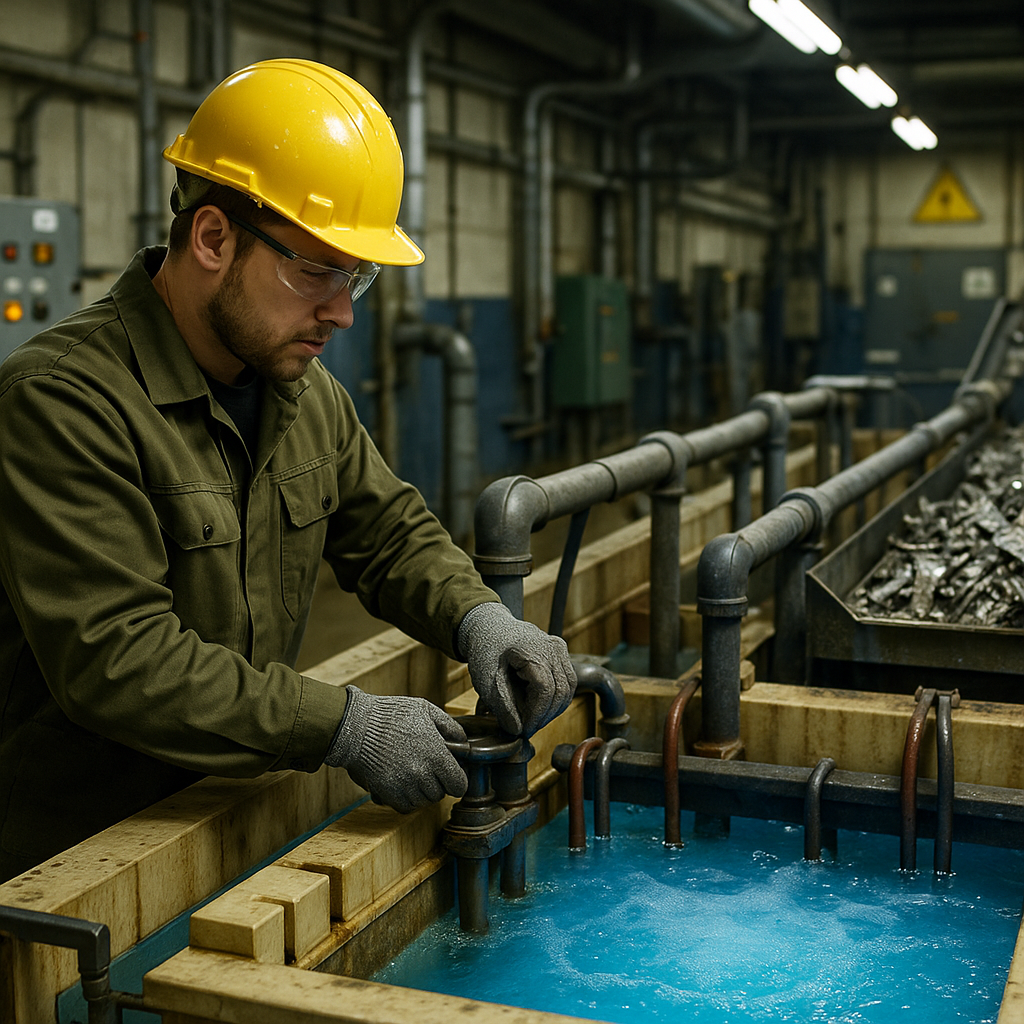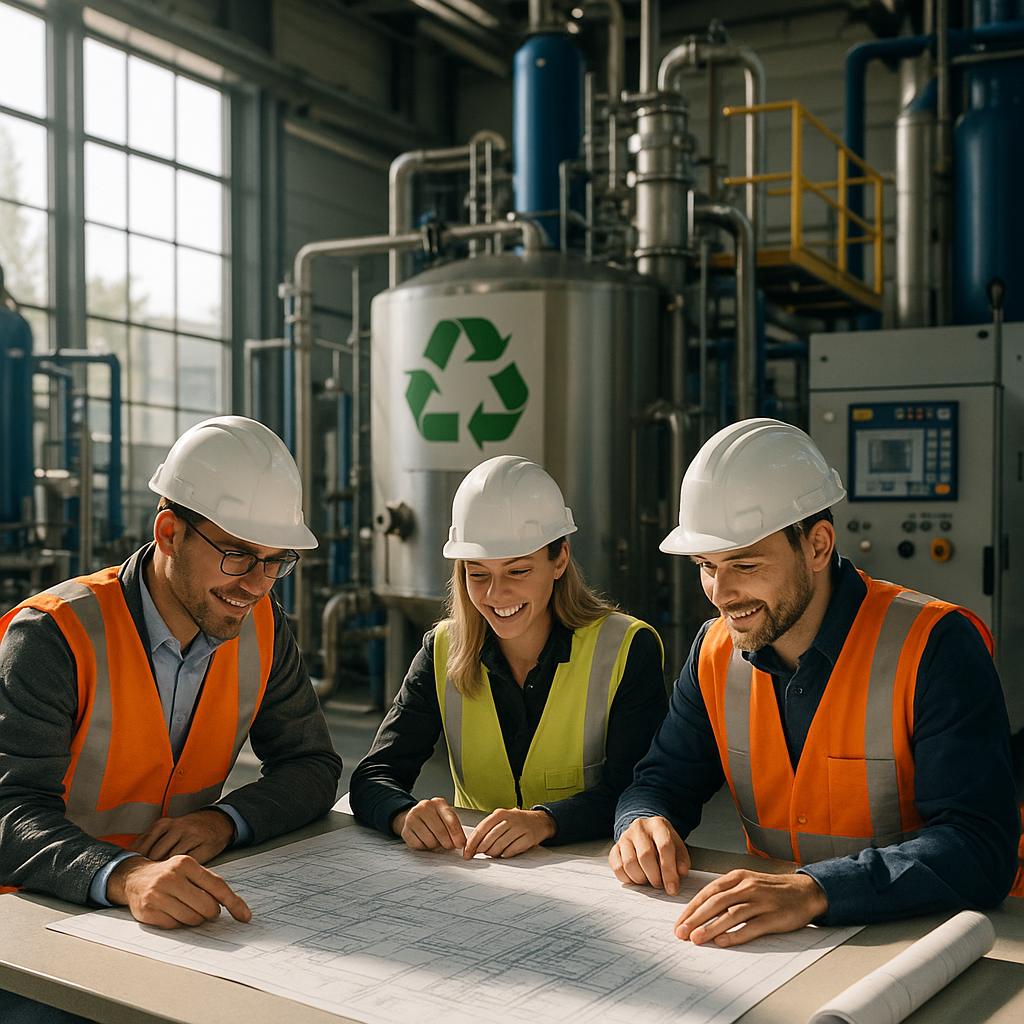5901 Botham Jean Blvd, Dallas, TX 75215
Electrolysis Metal Recycling: Process, Benefits, and Industrial Applications
October 1, 2025Electrolysis metal recycling is an advanced electrochemical technique used to recover and purify metals from scrap and waste materials. This process utilizes electricity to separate valuable metals from impurities. It operates by passing an electric current through a solution containing metal ions, causing pure metal to deposit at one electrode.
As global awareness of resource conservation grows, electrolysis recycling has become essential for sustainable metal recovery. The technique is particularly valuable for recovering high-value metals like copper, aluminum, and precious metals from electronic waste. These metals can be recycled repeatedly without losing their properties.
The increasing significance of electrolysis metal recycling is driven by both economic and environmental factors. It enables recyclers to produce metals with purities as high as 99.99%, making them suitable for demanding industrial applications. By recovering metals from waste streams instead of mining new materials, this process significantly reduces energy consumption and carbon emissions.
How Does the Electrolysis Recycling Process Work?

The electrolysis recycling process is an effective method for recovering high-purity metals from waste. This sophisticated yet straightforward process transforms mixed metal waste into pure metals through a series of well-defined steps.
The process begins with the thorough collection and sorting of metal-containing waste. Different types of metals require specific treatment parameters, making this initial sorting crucial for successful recovery. Electronic waste, industrial byproducts, and other metal scraps are categorized based on their metal content and physical properties.
Preparation Phase
Once sorted, the metals undergo preparation for the electrolytic process. This typically involves crushing or shredding larger pieces to increase surface area. The metals are then melted in a furnace to form a more homogeneous mixture. This melting stage helps separate some initial impurities, as different components may have varying melting points.
The Electrolytic Cell Setup
The heart of the process occurs in the electrolytic cell. This cell consists of two electrodes—an anode (positively charged) and a cathode (negatively charged)—submerged in an electrolyte solution specifically formulated for the target metals. The composition of this electrolyte varies depending on the metals being recovered, but often contains metal salts and acid solutions that facilitate ion movement.
The electrolyte solution functions as a pathway that allows metal ions to travel between electrodes. For copper recovery, a solution of copper sulfate and sulfuric acid creates an ideal environment for copper ions to mobilize.
The Electrochemical Reaction
When direct current is applied to the system, a transformation occurs. At the anode, metal atoms lose electrons and dissolve into the electrolyte as positively charged ions. These metal ions are attracted to the negatively charged cathode, where they pick up electrons and deposit as pure metal.
This electrochemical reaction can be visualized as a metal atom being disassembled at one end of the cell, transported across the solution, and reassembled in purified form at the other end. During this journey, impurities are left behind either in the solution or as a sludge at the bottom of the cell.
Metal Deposition and Purification
The cathode gradually accumulates a layer of high-purity metal through this deposition process. The purity levels achieved through electrolysis are remarkable—often exceeding 99.9% for metals like copper, gold, and silver. This makes electrolysis particularly valuable for recovering precious and industrial metals that require high purity for subsequent applications.
The process’s effectiveness lies in its selectivity. By carefully controlling the voltage applied to the cell, operators can target specific metals for recovery. Different metals require different reduction potentials— the electrical voltage needed to deposit them from solution—allowing for selective recovery even from complex mixtures.
Efficiency and Scalability
The electrolysis process offers exceptional efficiency for metal recovery. For copper recycling, recovery rates typically reach 95-98%, significantly higher than many alternative methods. The process is also highly scalable, functioning effectively in settings ranging from small refining operations to industrial-scale recycling facilities.
Modern electrolysis systems incorporate advanced monitoring and control systems that optimize current density, temperature, and electrolyte composition in real-time. These improvements have significantly reduced energy consumption while increasing recovery rates and purity levels.
Through this controlled electrochemical process, valuable metals are given new life, reducing dependence on primary mining while recovering high-value materials that would otherwise be lost to landfills or less efficient recovery methods.
What Are the Benefits of Electrolysis in Metal Recycling?

Electrolysis stands out as a superior method for recovering metals from waste streams. This process uses electrical current to separate and recover metals with remarkable precision, offering several critical advantages over traditional recycling techniques.
The most significant benefit of electrolysis in metal recycling is the exceptional purity of recovered metals. When properly implemented, electrolysis can produce metals with purities reaching 99.99% for copper, far exceeding the 85-90% purity achievable through precipitation processes or the 50-75% purity from pyrometallurgical smelting. These high-purity metals can be directly reused in manufacturing applications without additional refining.
Electrolytic recovery also delivers impressive energy efficiency advantages. The process requires less energy than traditional smelting operations, particularly when using optimized operating parameters. For instance, adding iron ions during copper recovery can reduce cell voltage from 1.9V to 0.7V, significantly decreasing energy consumption. This energy optimization makes electrolysis increasingly viable for industrial-scale metal recovery.
From an environmental perspective, electrolysis offers substantial benefits:
- Reduced carbon footprint compared to mining new metals
- Minimal chemical waste production, as many electrolytes can be regenerated
- Lower environmental impact than pyrometallurgical and hydrometallurgical alternatives
- Prevention of heavy metals entering landfills or water systems
Electrolysis excels at recovering rare and precious metals that would otherwise be lost. The process can selectively extract valuable metals like gold, silver, palladium, and platinum from complex electronic waste streams. It can also recover critical rare earth elements such as neodymium from permanent magnets with recovery rates exceeding 93%.
The economic case for electrolytic recycling continues to strengthen. The capital investment required for electrochemical processing facilities (approximately $6.8 million for a 20 kt/year operation) is substantially lower than comparable pyrometallurgical facilities ($15 million for 30 kt/year capacity). As demand for metals increases and mining costs rise, the value proposition for electrolysis in recycling becomes even more compelling.
Modern advances in electrolysis technology, including pulsed current techniques, ionic liquid electrolytes, and supercritical fluid methods, have further enhanced recovery efficiencies while enabling the processing of previously challenging materials. These innovations are expanding the range of metals that can be economically recovered through electrolysis.
| Method | Purity Levels (%) |
|---|---|
| Electrolysis | 99.99 |
| Hydrometallurgical Processes | 85-90 |
| Pyrometallurgical Smelting | 50-75 |
By providing a pathway for converting waste into high-value materials, electrolysis plays a crucial role in supporting circular economy principles. It transforms the recycling process from merely waste management to resource conservation, helping industries reduce their dependence on finite mineral resources while minimizing environmental impact.
What Industries Benefit from Electrolysis Metal Recycling?

Electrolysis metal recycling is a foundational technology across many industrial sectors. This efficient process enables the recovery and reuse of valuable metals that might otherwise end up in landfills or remain trapped in end-of-life products. Various key industries have integrated electrolysis into their recycling operations.
The Chlor-Alkali Industry
The chlor-alkali industry leads in electrolysis metal recycling innovation. This sector produces crucial chemicals like chlorine, caustic soda, and hydrogen through the electrolysis of brine. The electrodes used in these processes contain rare and precious metals such as iridium and ruthenium. As these components reach the end of their service life, electrolysis allows for the recovery of these valuable materials.
Recent initiatives highlight promising developments in this sector. In 2025, companies like Nobian and Asahi Kasei initiated collaborative recycling projects targeting rare metal recovery from spent electrolyzers. These projects address the rising costs of rare metals essential for manufacturing electrolysis cells due to growing demand for batteries and electrical components. Electrolytic recycling can recover up to 90% of these precious metals for reuse in new electrodes, creating a circular value chain within the industry.
E-Waste Recycling Facilities
Electronic waste is one of the fastest-growing waste streams worldwide. E-waste recycling facilities use electrolysis to extract valuable metals like gold, silver, palladium, and copper from discarded electronics. This process provides significant environmental and economic benefits by preventing hazardous materials from entering landfills while reclaiming increasingly scarce metals.
According to the United Nations’ Global E-Waste Monitor, global e-waste hit record highs in 2024, with only about 20% properly recycled. This presents both an environmental challenge and a financial opportunity. Electrolysis allows recyclers to extract metals with higher purity than other methods, making the recovered materials suitable for immediate reuse in manufacturing.
Scrap Yards and Metal Refineries
Scrap metal recycling has transformed from simple collection and melting operations to sophisticated processing facilities. Modern scrap yards and metal refineries use electrolysis to purify and separate different types of metals from mixed scrap sources. This results in high-quality recycled metals that meet strict industry specifications.
The process is especially valuable for separating metals with similar properties or removing impurities that would otherwise degrade the recycled material. For example, automotive-grade steel requires a maximum copper content of 0.06%, a level difficult to achieve through conventional recycling. Electrolysis provides the precision needed to meet these exacting standards.
The Automotive Industry
The automotive sector increasingly relies on recycled metals to reduce its environmental impact. Nearly 75% of a vehicle’s weight comes from steel and aluminum, much of which can be recycled through various methods, including electrolysis.
Catalytic converters are a particularly valuable application for electrolysis recycling. These components contain platinum group metals (PGMs) like platinum, palladium, and rhodium that can be efficiently recovered through electrolytic processes. With the increasing adoption of electric vehicles, manufacturers are also investing in recycling technologies for recovering metals from spent batteries and motor components.
Major automakers like Volvo and BMW are committed to using more recycled metals. Volvo aims to use 25% recycled steel by 2025 and 35% by 2030, while BMW plans to incorporate 50% scrap steel by 2030. These commitments drive investment in advanced recycling technologies, including electrolysis.
Conclusion: The Future of Electrolysis in Metal Recycling

Electrolysis metal recycling is a cornerstone technology in the shift towards a sustainable and circular economy. This method is crucial for conserving natural resources and minimizing the environmental impact of metal production. By utilizing electrical energy to recover metals with high purity, electrolysis provides an efficient alternative to conventional extraction methods, which often cause habitat destruction, water contamination, and excessive greenhouse gas emissions.
As global demand for metals increases and primary resources dwindle, the importance of electrolysis in metal recycling will continue to grow. This process offers significant benefits, including substantial energy savings compared to virgin metal production, significant carbon emissions reduction, and the ability to recover critical materials that might otherwise end up in landfills. These advantages make electrolysis a key technology in addressing resource scarcity and environmental conservation challenges.
For your metal recycling needs and to contribute to this vital sustainability effort, contact Okon Recycling at 214-717-4083.
